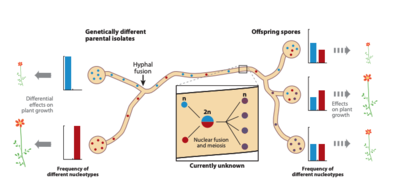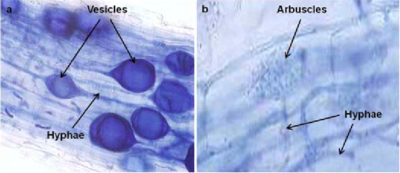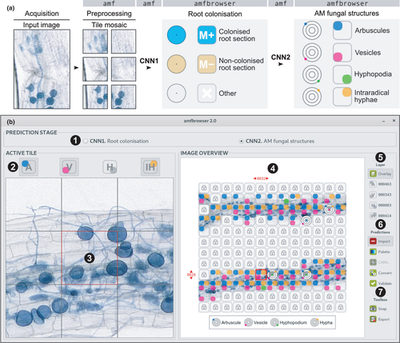The Underground Network: Arbuscular Mycorrhizal Fungi - Sebastian Jones: Difference between revisions
No edit summary |
No edit summary |
||
| Line 30: | Line 30: | ||
==Genetics== | ==Genetics== | ||
As with the technology used to analyze AMF, there has also been considerable advancements in the understanding of AMF genetics. Using rice (Oryza sativa) as a model organism, researchers have studied the genes necessary for mycorrhizal formation <b>REF16</b>. The genes CASTOR, POLLUX, CCAMK (DMI3), and CYCLOPS were found to be critical for the formation of mycorrhiza in legumes and rice <b>REF16</b>. However, there were two groups types of genes found that are specific only to mycorrhiza formation. The first group is expressed early in development. It includes AM1-3 and AM11. The second group contains genes that are expressed later in development <b>REF16</b>. These genes are: AM10, 11, 14, 15, 18, 20, 24, 25, 26, 29, 31, 34, 39, 42 and PT11. Additionally, phosphate transport is hugely important to in the symbiotic relationship of plants and AMF, two plant phosphate transporters have been identified. Genes PT4 and PT3 in addition to contributing to phosphate transport are also believed to have a role in maintenance and life span of arbuscles <b>REF17</b>. Given that they are expressed in the arbuscle, these genes are thought to have a significant role in symbiosis <b>REF17</b>. | As with the technology used to analyze AMF, there has also been considerable advancements in the understanding of AMF genetics. Using rice (Oryza sativa) as a model organism, researchers have studied the genes necessary for mycorrhizal formation <b>REF16</b>. The genes CASTOR, POLLUX, CCAMK (DMI3), and CYCLOPS were found to be critical for the formation of mycorrhiza in legumes and rice <b>REF16</b>. However, there were two groups types of genes found that are specific only to mycorrhiza formation. The first group is expressed early in development. It includes AM1-3 and AM11. The second group contains genes that are expressed later in development <b>REF16</b>. These genes are: AM10, 11, 14, 15, 18, 20, 24, 25, 26, 29, 31, 34, 39, 42 and PT11. Additionally, phosphate transport is hugely important to in the symbiotic relationship of plants and AMF, two plant phosphate transporters have been identified. Genes PT4 and PT3 in addition to contributing to phosphate transport are also believed to have a role in maintenance and life span of arbuscles <b>REF17</b>. Given that they are expressed in the arbuscle, these genes are thought to have a significant role in symbiosis <b>REF17</b>. | ||
<b>Nuclei Exchange and Recombination</b> <br> | |||
[[Image:AMF_fusion.png|thumb|400px|right|Image 3, hyphal fusion between the nuclei of two genetically different AMF spores followed by reproduction and the resulting recombination in the offspring. The genetic information of each parent is shown in one of the two colors. Due to the signifiant amount that is unknown about the process depicted above and which parts contribute to which results, the authors state that "This as a priority research." | |||
priority for research on this symbiosis. [<b>REF13</b>].]] | |||
Another aspect of arbuscular mycorrhizal fungal genetics that is being researched but currently, not completely understood is the process of nuclear fusion and then meiosis between two genetically different parental AMF. | |||
| Line 35: | Line 41: | ||
As previously mentioned, the significant lack of knowledge of AMF genetics has significantly hindered overall research. There are a number of factors that have contributed to the lack of understand. The most significant is that AMF have long been believed to be asexual organisms. Mendelian methods for studying genetics have not been used to study AMF and this has significantly limited our understanding. In addition, AMF are difficult to study as they have to be grown on plants. This necessity adds significant complexity and a huge number of possible variables that could be overlooked and unknowingly lead to a misguided truth. Other reasons include the genome Organization, genetic variation and the population genetics of AMF <b>REF13</b> | As previously mentioned, the significant lack of knowledge of AMF genetics has significantly hindered overall research. There are a number of factors that have contributed to the lack of understand. The most significant is that AMF have long been believed to be asexual organisms. Mendelian methods for studying genetics have not been used to study AMF and this has significantly limited our understanding. In addition, AMF are difficult to study as they have to be grown on plants. This necessity adds significant complexity and a huge number of possible variables that could be overlooked and unknowingly lead to a misguided truth. Other reasons include the genome Organization, genetic variation and the population genetics of AMF <b>REF13</b> | ||
Revision as of 05:36, 7 December 2022
Overview
Arbuscular Mycorrhizal Fungi (AMF) are a symbiotic fungi that colonize plant roots. They are identifiable by their unique structures vesicles, hyphae and arbuscles (Image 1). Three of the most common types of mycorrhizal symbioses are, ectomycorrhizal, endomycorrhizal and ecto-endomycrorizha. AMF's are the second, endomycorrhizal REF10. Arbuscular Mycorrhizal Fungi play many roles in an ecosystem. One of the most important roles of the AMF is the transfer of Phosphorous and Carbon between it and the host plant REF. In addition, they increase the resistance of their host to salinity and heavy metals REF, insects REF, droughts REF, and soil pathogens. They have also been shown to contribute to enhanced soil; Increasing soil structure, particularly in agricultural settings and preventing the loss of important nutrients due to rainfall REF.
History
The human history of understanding Arbuscular Mycorrhizal Fungi began in 1840 when Robert Hartig when he thought he was describing a root parasite, however, paleobotanical, morphological and phylogenetic data show that more than 400 million years, plants and AMF have coevolved REF11. Then in 1885, Albert Bernard Frank was the first to conceptualize it. Research has continued to this day with constant technological advances allowing new discoveries to be nearly constantly made. A recent important technological advancement was the advent of computer software that automatically quantifies the degree of AMF colonization of a plant root. The discovery was made by Cambridge's Sainsbury Laboratory and it is called AMFinder. It was developed with convolutional neural networks and it is able to accurately identify colonization in several plants commonly used in AMF research REF12.
Genetics
Genetics
As with the technology used to analyze AMF, there has also been considerable advancements in the understanding of AMF genetics. Using rice (Oryza sativa) as a model organism, researchers have studied the genes necessary for mycorrhizal formation REF16. The genes CASTOR, POLLUX, CCAMK (DMI3), and CYCLOPS were found to be critical for the formation of mycorrhiza in legumes and rice REF16. However, there were two groups types of genes found that are specific only to mycorrhiza formation. The first group is expressed early in development. It includes AM1-3 and AM11. The second group contains genes that are expressed later in development REF16. These genes are: AM10, 11, 14, 15, 18, 20, 24, 25, 26, 29, 31, 34, 39, 42 and PT11. Additionally, phosphate transport is hugely important to in the symbiotic relationship of plants and AMF, two plant phosphate transporters have been identified. Genes PT4 and PT3 in addition to contributing to phosphate transport are also believed to have a role in maintenance and life span of arbuscles REF17. Given that they are expressed in the arbuscle, these genes are thought to have a significant role in symbiosis REF17.
Nuclei Exchange and Recombination

Another aspect of arbuscular mycorrhizal fungal genetics that is being researched but currently, not completely understood is the process of nuclear fusion and then meiosis between two genetically different parental AMF.
Limitations to Our Understanding Arbuscular Mycorrhizal Fungal Genetics
As previously mentioned, the significant lack of knowledge of AMF genetics has significantly hindered overall research. There are a number of factors that have contributed to the lack of understand. The most significant is that AMF have long been believed to be asexual organisms. Mendelian methods for studying genetics have not been used to study AMF and this has significantly limited our understanding. In addition, AMF are difficult to study as they have to be grown on plants. This necessity adds significant complexity and a huge number of possible variables that could be overlooked and unknowingly lead to a misguided truth. Other reasons include the genome Organization, genetic variation and the population genetics of AMF REF13
Include some current research, with at least one image.
Sample citations: [1]
[2]
A citation code consists of a hyperlinked reference within "ref" begin and end codes.
For multiple use of the same inline citation or footnote, you can use the named references feature, choosing a name to identify the inline citation, and typing [4]
Second citation of Ref 1: [1]
Microbiome
Include some current research, with a second image.
Conclusion
Overall text length (all text sections) should be at least 1,000 words (before counting references), with at least 2 images.
Include at least 5 references under References section.
References
- ↑ 1.0 1.1 Hodgkin, J. and Partridge, F.A. "Caenorhabditis elegans meets microsporidia: the nematode killers from Paris." 2008. PLoS Biology 6:2634-2637.
- ↑ Bartlett et al.: Oncolytic viruses as therapeutic cancer vaccines. Molecular Cancer 2013 12:103.
- ↑ Lee G, Low RI, Amsterdam EA, Demaria AN, Huber PW, Mason DT. Hemodynamic effects of morphine and nalbuphine in acute myocardial infarction. Clinical Pharmacology & Therapeutics. 1981 May;29(5):576-81.
- ↑ 4.0 4.1 text of the citation
Edited by [Sebastian Jones], student of Joan Slonczewski for BIOL 116 Information in Living Systems, 2022, Kenyon College.


